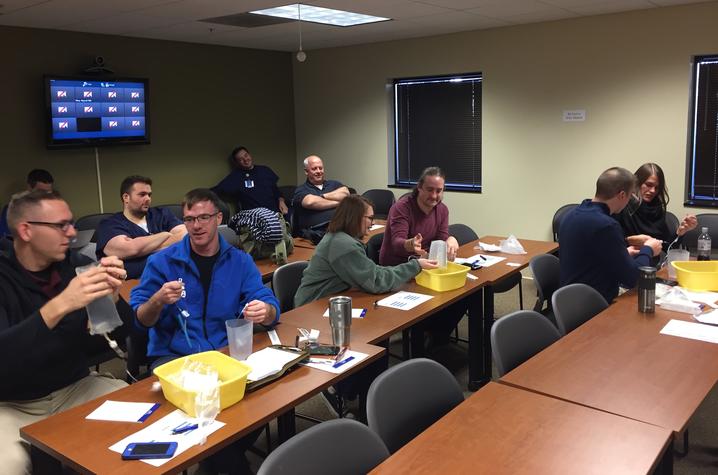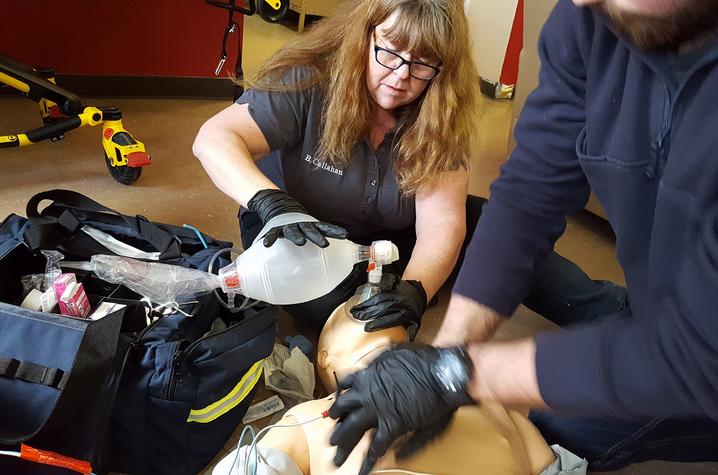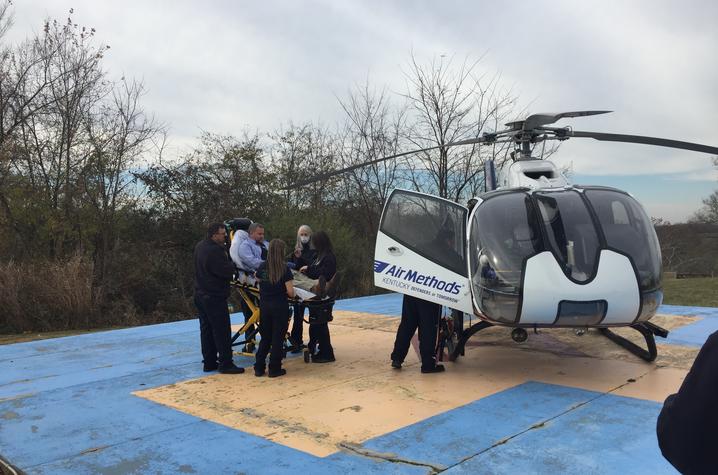Community Paramedicine Pilot Projects Address Gaps, Reduce Costs of Emergency Medicine
LEXINGTON, Ky. (May 10, 2017) — The utility of emergency medical services in the healthcare delivery spectrum is undisputable, as speedy access to medical intervention increases survival for desperately sick people. However, factors such as a shrinking supply of primary care doctors have increased the burdens on emergency rooms and the EMS personnel tasked with responding to 911 calls.
Emergency departments are overcrowded and waits to see a provider can be long. The cost is much higher than a primary care physician would charge for the same care, and 911 services struggle to accommodate the soaring number of calls.
The problem can be compounded in rural communities with few primary care resources, or during the evenings and weekends when a primary care provider's office is typically closed.
"EMS and ED personnel and equipment are designed for acute, episodic health problems and cost structures reflect that," says Dr. Walter Lubbers, EMS medical director at UK HealthCare.
"To use emergency services for less urgent, chronic health problems is like using a 2,000-pound bomb when you need a rifle."
According to the University of Iowa, about 5 percent of patients in the U.S. account for 25 percent of ER visits. Often, these frequent visits result when one person calls 911 repeatedly for what is considered non-emergency care. These "super-utilizers" typically have complex and precarious health statuses, sometimes complicated further by behavioral and social issues. They bounce in and out of emergency departments and hospitals, which is expensive, stressful and ineffective for all involved.
A new subspecialty service — termed "Community Paramedicine" or "Mobile Integrated Health"— seeks to fill those gaps with the aim to lower costs, reduce burdens on emergency personnel and resources, and improve quality by matching patients to the appropriate level of care. Lubbers is spearheading the implementation of several CP/MIH pilot projects in Kentucky.
The CP/MIH concept began in Europe and spread to places like Canada and Australia, where there are large swaths of rural areas with limited access to health care. In the early 2000's, states like California and New Mexico began to take note and explore how they could adapt CP/MIH to address their own problems.
One option to reduce costly hospital readmissions is to extend a paramedic's role beyond a patient's hospital discharge so that paramedics can loop back and check in on patients, make sure they are following their post-discharge instructions, look for signs that a patient needs more medical attention (for example, a fever that might suggest infection) and identify hazards at home that might land patients back in the hospital (such as trip hazards for patients who use walkers).
"If we can catch issues before they become emergencies, we help keep the patient safely at home, reduce post-discharge complications, ease the pressure on EMS and hospital resources, and lower costs all around," said Lubbers.
Unnecessary emergency room visits are also a significant driver of costs, so finding ways to divert super-utilizers to the appropriate level of care can reduce financial burden. Minnesota's CP/MIH program identifies super-utilizers and converts them to a managed care approach that addresses medical, social and behavioral needs. For example, a quick check of a diabetic patient's refrigerator might tip a visiting community paramedic off to poor nutrition, which then precipitates an appointment with a nutritionist or social services. Through the program, Minnesota has seen ER use by super-utilizers decrease by 60 to 70 percent.
In Kentucky, a handful of pilot programs sets different goals for different cities. Louisville has a stubborn super-utilizer problem, while projects in Oldham County, Paducah and Montgomery County are focusing on reducing hospital readmissions.
Todd Early, RN, EMTP, directs the pilot program in Oldham County, working with the local hospital to identify patients at risk of readmission. Community paramedics – who received additional training to prepare them for their new role – visit patients in the hospital at the time of their discharge and at the patient's home on Days 3, 7 and 14 post-discharge. "We've caught and corrected several problems that absolutely kept these patients from needing to return to the hospital," Early said.
According to Early, initial data from the Oldham pilot are directionally positive. Furthermore, he adds, they've had excellent feedback from the local primary care providers, where demand outstrips supply. Even better: patient satisfaction surveys are "off the chart positive," Early said. "We still need to measure the positives against the cost investment, but for now it appears to be a win-win-win situation."
Data from the other three pilot projects in Kentucky are also encouraging: an estimated 477 EMS transports were prevented from Dec. 1, 2016 through Feb. 28, 2017, with an estimated 242 ED visits prevented. While Atlantic Monthly pegs the average national cost of an emergency room visit at about $2,000, it's tricky to extrapolate Kentucky's initial successes to dollars and cents. "Regardless," says Lubbers, "the patient benefit is huge."
As a kid in Northern Kentucky, Lubbers watched the University of Cincinnati helicopter ferry patients to the hospital and dreamt of being a paramedic or a doctor. In medical school, he was drawn to surgery — until he began his surgery rotation. "That interest lasted about one and a half days," he said. His next rotation was, thankfully, emergency medicine. After just a week, Lubber recalls saying to himself, "Yeah, I'm home." As such, he's a natural fit for the project.
Even with the pilot projects' initial successes, there's a long way to go before cities statewide can roll out their own programs. First up: changing the legislative code, which currently makes "non-scheduled, non-emergency visits" illegal.
Meanwhile, UK HealthCare is carefully watching the pilot's progress with an eye on the possibility of a similar project in Lexington.
"We want to do everything we can to keep our patients healthy and out of the hospital, and the community paramedicine concept appears to be a good candidate to achieve that," said Dr. Roger Humphries, chair of the UK Department of Emergency Medicine. "We can answer patient's questions and reduce confusion about their post-discharge care plans without returning them to the hospital or clinic, which is cost-effective but, more importantly, a comfort to them."







